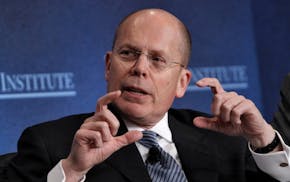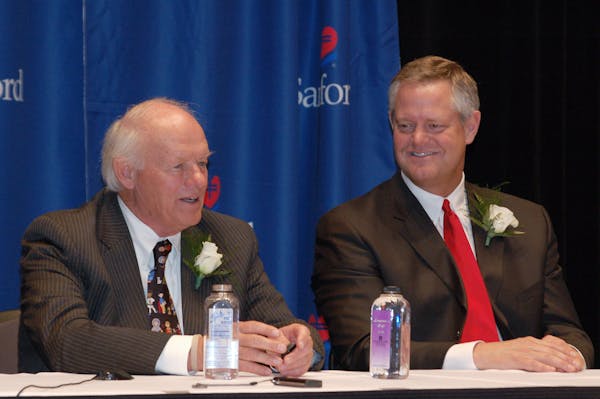Sanford and Fairview health systems say their proposed mega-merger would invest about $500 million in strategic capital in hospitals, facilities and growth initiatives across the Minnesota communities where Fairview currently operates.
Additionally, the CEOs at the health systems say benefactor Denny Sanford has pledged to make Sanford Health the primary beneficiary of his estate subject to certain conditions, including that the combined company locate its headquarters in Sioux Falls, S.D.
The details came Monday through a data release plus an interview with the Star Tribune that amounted to one of the deepest looks at terms of the tie-up since the health systems first announced their plans in November.
The timeframe for the strategic capital investment hasn't yet been determined, Sanford Health chief executive Bill Gassen said in the interview. It's too early to say, he added, whether the sum might change if the University of Minnesota moves forward with its plans to regain control of University of Minnesota Medical Center — the Minneapolis teaching hospital that's the largest within Fairview Health Services.
"That is strategic capital," Gassen said of the $500 million, which is part of the Sept. 8 letter of intent for the merger that the health systems publicly released for the first time on Monday. "What we mean by that is, this is above and beyond what would be the normal, routine capital that today Fairview spends as a part of just continuing to run the organization."
If the merger is completed, the new South Dakota-based health system would create a regional board for the legacy Fairview operations. This board would play a key role in determining which strategic projects to fund, Gassen said, adding that the investments likely would go beyond spending on current Fairview facilities.
"It could be new facilities, it could absolutely be net new programming — offerings that don't exist today or augmentations of those that already exist today," he said.
The health systems also released a letter sent to Minnesota lawmakers on Monday disclosing that Denny Sanford — a South Dakota businessman and philanthropist who founded First Premier Bank — has "declared his legacy giving intentions that Sanford Health will be the primary beneficiary of his estate."
The "cornerstone commitments" for this continued philanthropic giving align with certain terms of the proposed merger, the CEOs wrote, including the headquarters provision and agreement that Sioux Falls will be the location for the health system's CEO and the majority of entity-level administrative staff.
Sanford has contributed nearly $1.5 billion to the South Dakota-based health system since 2004, the letter states.
"Post-close, the benefit of Mr. Sanford's generosity will extend to more Minnesota communities and patients, including those in legacy Fairview's service area," Gassen and James Hereford, the CEO at Minneapolis-based Fairview Health Services, wrote in their Monday letter.
"The combined system will also have a material corporate presence in the Twin Cities," the letter states. The new Sanford Health "will remain a not-for-profit entity domiciled in North or South Dakota, which will serve as a parent entity with Fairview Health Services continuing as a not-for-profit entity operating in Minnesota."
In November, the health systems announced plans to create one of the largest health systems in the Upper Midwest with more than 50 hospitals and some 78,000 employees.
Sanford and Fairview officials agreed last month to release the letter of intent after Minnesota lawmakers raised questions about the merger.
On Friday, Sanford and Fairview said they agreed to push back the target for completing their merger until May 31, a two-month delay that came after weeks of pressure for more time by lawmakers, the University of Minnesota and Minnesota Attorney General Keith Ellison.
Since 1997, Fairview has owned the University of Minnesota Medical Center in Minneapolis. University officials have pushed to slow the merger until questions are answered about the impact on the U's academic medicine mission.
In the letter of intent, Sanford and Fairview officials say they hoped to "enhance this academic medicine relationship" and talked about exploring "partnership opportunities with the University and University of Minnesota Physicians at a mutually agreed upon time."
Last week, the chair of the U's Board of Regents criticized the health systems for not giving the U more notice about the proposed deal. He called on Sanford and Fairview to publicly support a five-point plan announced in January for the university to regain control of its Minneapolis teaching hospital and ultimately build a new medical center on the East Bank campus.
Gassen said Monday he was "optimistic" that an agreement still could be reached whereby the U is part of the new health system.
"We're continuing to meet with them now on pretty close to a weekly basis," he said.
Health systems typically devote about 3% to 5% of revenue to capital investments, which works out to roughly $300 million per year at Fairview, said Hereford, the chief executive. Given recent financial challenges, however, Fairview's capital investments have been diminished to manage cash flow, he said.
Fairview has identified a long list of strategic initiatives the health system is struggling to fund, he said, such as further investments in higher-tech services at St. John's Hospital in Maplewood.
"It just would go much slower," he said, "without the sort of strategic capital that [Sanford Health] has committed to the region."
Gassen added: "We really want to make sure we're moving the needle on the items that you've heard [Hereford] and I talk about — it's how do you improve access, how do we improve quality, how do we expand services, how do we drive equitable health care."
The CEOs' letter to lawmakers referenced commitments the health systems said they made through a Jan. 27 letter to the attorney general. They say they've agreed to honor Fairview's current affiliation agreement with the U through 2026 and committed that the merger would not result in fewer options for gender-affirming care and comprehensive women's health care including abortion.
Several speakers at public meetings in January raised concerns about continuing access to abortion and health care for LGBTQ communities with the merger.
"This merger would not result in layoffs for non-executive employees or the closure or sale of facilities," the CEOs said of their commitments to the attorney general. "The combined system will continue to honor our existing collective bargaining agreements" and "the merger will not result in the diversion from the state of any assets donated in Minnesota."

Prices for international flights drop as major airlines navigate choppy economic climate
Minnesota's med spa industry rises in popularity — and with little regulation

Hundreds line up at Best Buy to nab Nintendo Switch 2, in scene like '90s opening parties

